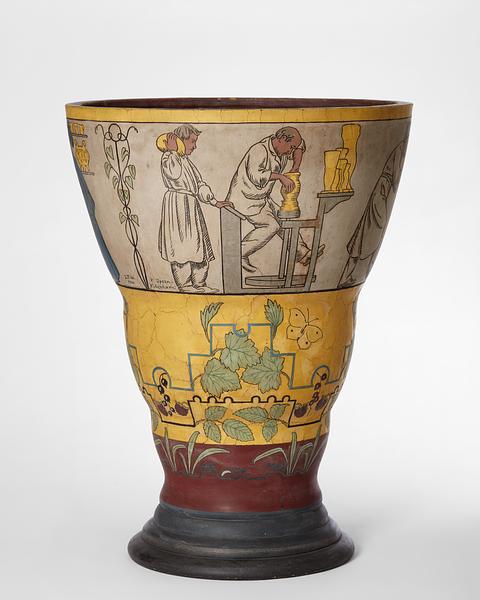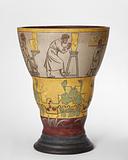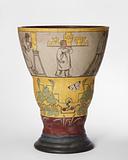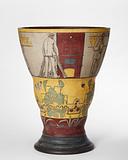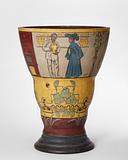J.F. Willumsen created
The Potter Vase for P. Ipsens Enke Terracottafabrik with a view to exhibiting it at the 1900 Exposition Universelle in Paris that same year. Although it did not win the gold medal and had little impact on the company, Willumsen, or the overall development of Danish ceramics at the time, it is now considered a ceramic masterpiece within the realm of Danish art.
The most distinctive feature of
The Potter Vase is first and foremost the technique, which was developed by Willumsen and Bertel Ipsen in 1899 in connection with plans to restore Jørgen Sonne’s frieze at Thorvaldsens Museum.
[1] The vase is made of unglazed earthenware decorated with different coloured slips in five bands. Willumsen did not turn the vase himself but drew a design to which the chief thrower at P. Ipsens Enke, Hans Lund, referred while working.
[2]The vase was named after the eye-catching frieze that adorns its upper part. Here, a number of different scenes are played out, all bearing witness to the working processes typical of a pottery company like P. Ipsens Enke in the year 1900: A lump of clay is brought to a potter, who uses it to turn a vase, which is then decorated by an artist. Next, we see a range of ceramic objects being carried to the kiln, which is overseen by the kiln master. Finally, a vase of classical outline is presented to a customer.
Close inspection reveals that there are not just great similarities between
The Potter Vase and the vase being turned and decorated in the frieze depiction. A similar kinship can be found between the potter depicted and Hans Lund, as well as between the artist decorating the vase and Willumsen himself. In addition, the vase being presented to the customer in the frieze is of a type reminiscent of the antique style used in some of P. Ipsens Enke’s creations.
However, prior to the Exposition Universelle the task of making
The Potter Vase had proven more difficult than expected. There were problems with the yellow colour, which was prone to crazing when fired.
[3] As a result, two versions of
The Potter Vase were created, identical except for the colour of the upper and middle band. The first version of the vase was yellow, had cracks and was not exhibited. The second version was blue, intact and was sent to Paris. It is the former version, the one corresponding to Willumsen’s original design, that is now seen in The David Collection.
Inv. no. B 454
Published in:
Charles Been: ”Pottemagervasen”, Tidsskrift for Industri, 1900, pp. 131-132;
Kai Flor: A/S P. Ipsens Enke 1843-1943, 100 år Terrakotta Virksomhed, København 1943;
Erik Zahle: ”Billedkunst” in C.L. Davids Samling. Nogle Studier, [1], København 1948, p. 208;
J.F Willumsen: Mine Erindringer fortalt til Ernst Mentze med biografiske Oplysninger, Noter og Kommentarer, København 1953, pp. 130-131;
C.L. David: C.L. Davids Samling, København 1960, p. 23;
Roald Nasgaard: Willumsen and symbolist art 1888-1910, Diss. New York University 1973, printed 1996, pp. 266-267, 271;
Leila Krogh: Willumsens keramiske værker, 1891-1900, J.F. Willumsens Museum, Frederikssund 1986, cat. 90, pl. 23, pp. 54, 99 and pl. 9, p. 40;
Bente Holst: P. Ipsens Enke Kgl. Hof Terrakottafabrik. En verdensberømt kunstindustriel virksomhed på Utterslev Mark, Speciel ed. of Historiske meddelelser om København, Yearbook 1987, pp. 80-82;
Bente Holst: P. Ipsens Enke: en keramisk fabrik gennem 100 år, Nikolaj, København 1990, pp. 15, 30-33;
Lise Seisbøll: Keramisk kunst. Dansk kunstnerkeramik gennem 100 år, Brandts Klædefabrik Odense, København 1991, p. 31;
Leila Krogh in Kjeld von Folsach and Nana Lund (eds.): Dansk kunst i Davids Samling – fra Philipsen til Saxbo, København 1995, cat. 18, pp. 76-77;
Lars Dybdahl: Dansk keramik 1850-1997, Sophienholm, Kgs. Lyngby 1997, cat. 79;
Leila Krogh and Pia Guldager Bilde (eds.): Pegasus og Tanagra: antikken i J.F. Willumsens kunst og samling, J.F. Willumsens Museum, Frederikssund 1997, pp. 13, 24, 61-67, figs. 51, 53, 54, cat. 87;
Kathrine Jørgensen and Bente Holst: Et keramisk Eventyr. P. Ipsens Enke, Kgl. Hof Terrakottafabrik 1843-1955, København 2001, pp. 79-81, 105, 113;
Bente Scavenius: Grib Tiden. Kunsten 1890-1910, Kunstforeningen Gl. Strand, København 2004, cat. 243, pp. 34, 37, 79;
Leila Krogh: J.F. Willumsen – over grænser, Ordupgaard and Musée D’Orsay, Paris, Charlottenlund 2006, cat. 27, pp. 132-134, fig. 43;
Naja Rasmussen in Christian Gether, Stine Høholt, Camilla Jalvig (eds.): J.F. Willumsen. Farver og striber, Arken, Ishøj 2018, pp. 11-13;
Thomas Lederballe et al.: Hieroglyffer: symbolismens tegninger 1890-1910, Statens Museum for Kunst, København 2018 ,cat. 47, pp. 94-97;
Peder Rasmussen: Keramikkens sprog, København 2021, pp. 234-235;
Henrik Wivel: Jeg er en anden: en biografi om J.F. Willumsen, København 2024, Vol. 1, 1863-1914, fig. 100, pp. 152-154;
